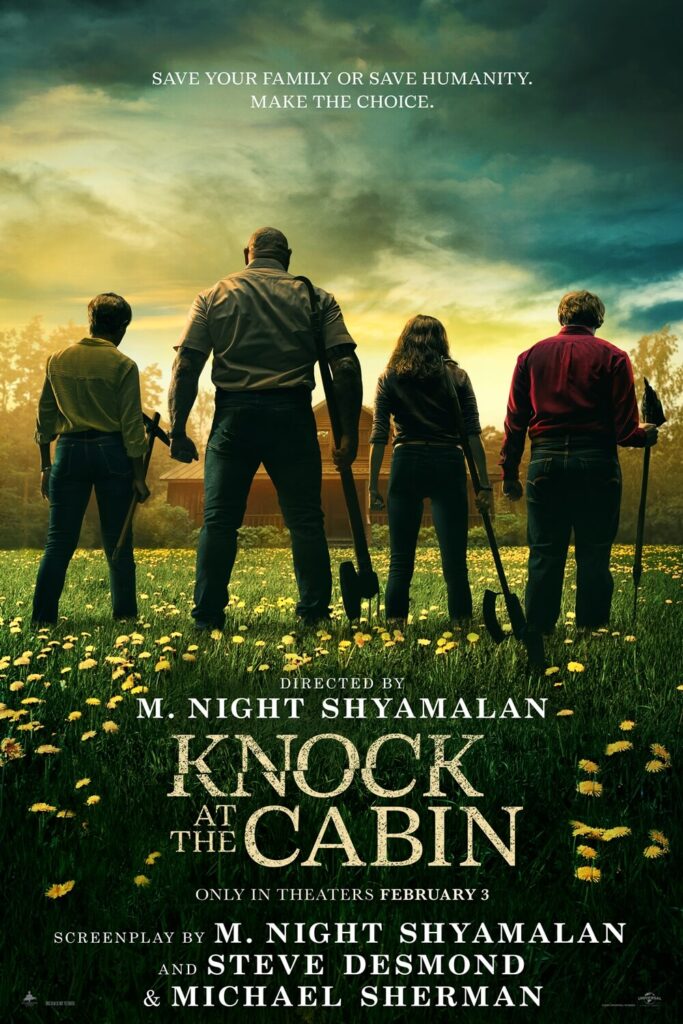Needing to broaden my film horizons beyond Clerks (1994) and Gummo (1997), I ventured out to see EA alumnus from the class of 1988, M. Night Shyamalan’s new film, Knock at the Cabin. Upon leaving the theater, my mind was racing with conflicting opinions. Shyamalan’s fifteenth film has lots to offer with lively characters but feels uneven in its pacing.

Photo courtesy of IMDb.com
The movie follows a doomsday group led by a second-grade teacher, Leonard, expertly played by Dave Bautista. The emotional range Bautista displays—from calming a young girl in chaotic times, to trying to convince two men that the future of the world lies in their hands—should confirm he will appear in the next Good Will Hunting (1997) or Manchester by the Sea (2016). Johnathan Groff challenges Bautista for best actor as he adapts to the emotionally draining role of a protective father, Eric, since playing Agent Holden in Mindhunter (2017-2019). Shyamalan’s mastery at directing actors and putting them into the character’s headspace is evident with Bautista and Groff.
A film highlight is the portrayal of Andrew (Ben Aldridge) and Eric’s relationship. The audience feels for them despite only getting ten minutes to explore the couple’s history with homophobia, violence, and their adopted daughter, Wen (Kristen Cui). The film utilizes every minute wisely as each character and their relationships are fleshed out just enough that a movie-goer pulls for them without superfluous information detracting from the “grand scheme.” Nonetheless, some things in this “grand scheme” (like one of the doomsdayer’s connection to the family) feel unnecessary.
What draws me to Shyamalan’s films is how quickly he throws audiences into the story. Five minutes into Shyamalan’s Signs (2002), Split (2017), and Unbreakable (2000), conflict is established. Likewise, Knock at the Cabin immediately shows the family meeting the doomsday “villains” (or “heroes” depending on how audiences interpret their actions). However, Shyamalan struggles with pacing dialogue, in part due to the film’s static cinematography.
Shyamalan’s early films like The Sixth Sense (1999), Praying with Anger (1992), and Wide Awake (1998) allow characters to breathe. Granted, Knock at the Cabin is nothing like the story of a young man going to India to learn about his roots, but the way the camera works with the dialogue makes it seem unnatural. Almost every shot is locked on the characters. This works at times by forcing the audience to face the character’s raw mental breakdowns and is reminiscent of how director Michael Haneke uses the camera in Funny Games (1997).
Despite this, there are points where cuts between talking characters feel out of place. The film would have benefitted from longer, hand-held shots that P.T. Anderson masters in Boogie Nights (1997) when Dirk is thrown out of his house or during the Little Bill New Years sequence. Dynamic shots make those scenes feel real and like the audience is in the room. Shyamalan does use an effect famous from Martin Scorcese’s Mean Streets (1973) which works perfectly in the scene’s context and demonstrates the director has an eye for experimental, captivating cinematography which he should rely on more often.
Knock at the Cabin is a film that will divide people who believe we are living in a Shyamalan revolution and those who think this is just another mediocre film. As I write from my own tiny camp that proudly labels Signs as Shyamalan’s best film, I think a rewatch of Knock at the Cabin and some conversation with the director (he knows how to reach me) could clarify some things to help me better appreciate the film. I give M. Night Shyamalan’s Knock at the Cabin six churchmen and one church mouse out of ten.